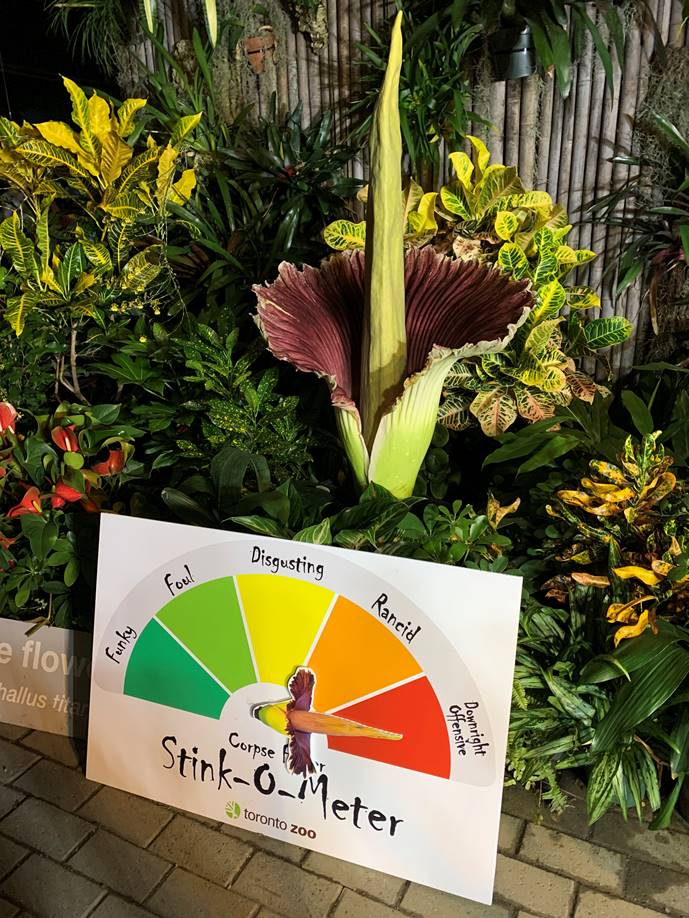
A RARE AFFAIR AT YOUR TORONTO ZOO CORPSE FLOWER “VINCENT VAN GROSS” BLOOMS

Corpse Flower ‘Vincent Van Gross’ in full bloom, Photo Credit: Toronto Zoo
FOR TIME-LAPSE FOOTAGE OF CORPSE FLOWER ‘VINCENT VAN GROSS’ BLOOMING,

TORONTO, ON, Sunday, August 9, 2020: What’s that smell? For the second time at your Toronto Zoo, our corpse plant (Amorphophallus titanum) officially named “Vincent Van Gross” began to bloom on Sunday, August 9, 2020 at approximately 1:15 pm. This species only blooms for eight to 36 hours and this is the second time this species has bloomed in the Greater Toronto Area (GTA), as this plant’s predecessor, Pablo “Pew-ew” Caso bloomed back in September 2018. It was a very exciting few days at the Toronto Zoo with the Corpse Flower Special Exhibit being open to public over the course of seven days, beginning Thursday, August 6, 2020 at 9:30 am through Wednesday, August 12, 2020 which included opportunities to see the corpse flower in various stages of pre-bloom, bloom and post-bloom. Hours of operation were extended to ensure guests had the opportunity to experience this horticultural phenomenon.
The Zoo's Horticulture Division currently cares for 11 specimens of Amorphophallus titanum – the titan arum, or, more descriptively, the corpse flower or stink plant. However, one of our seven-year-old species began to bloom early at approximately two years ahead of schedule. Native to the Indonesian island of Sumatra, the titan arum is related to peace and calla lilies. As you might guess from its name, the corpse flower's blossoms don't exactly smell like roses. Instead, this species relies on carrion beetles and flies for pollination, which it attracts with an aroma that – yes – resembles rotting meat. It's been called the plant kingdom's worst odour.
“Your Toronto Zoo houses a variety of plant species from around the world and is proud to be home to one of the largest tropical plant collections in Canada,” said Dolf DeJong, CEO, Toronto Zoo. “The corpse flower is one of the world’s largest and rarest flowering structures, one of Sumatra’s most coveted and threatened plants, which only blooms every couple of decades. Our entire team was excited to share such a rare and exciting experience with our community,” he added.
Grown from seed, it can take six to ten years for a plant to produce its first flower, after which it can take several more years for it to bloom again. One of the reasons it takes so long between blooms is that the titan arum produces one of the largest flowering structures in the entire world. The pale central "tower" of the inflorescence, known botanically as a spadix, is typically two metres tall! This is wrapped in a single large spathe – a modified leaf that looks like a big bell – shaped petal. To match the corpse flower's aroma, this spathe has a dark red, ridged interior, which looks just like a piece of exposed flesh. Flies and beetles attracted by the odour carry pollen from another corpse plant and crawl down the spathe to the base of the spadix, where female flowers await pollination. When cross pollination is successful, fruits are formed which later bear seeds. Since these pollinators tend to be nocturnal by nature, the blooms usually open in the late afternoon and then begin to wilt by the next morning. It's a lot of effort for a short window of opportunity. Our titan arum specimens arrived at the Zoo in 2013 from Niagara Botanical Garden, so it could still be years before the rest of the specimens share their unmistakable blossoms, and aroma, with us.
This plant species is unique because of how infrequent it blooms, and because of how little time it has to be pollinated by only three species of beetle. Plants use all sorts of techniques to encourage animals to pollinate their flowers. Bright colours, perfumed fragrances, and sweet nectar encourage butterflies, bees, hummingbirds, sunbirds, and even bats to visit flowers, inadvertently carrying pollen and fertilizing seeds along the way. But while sweet-smelling, colourful flowers have been cultivated extensively by humans, this is not the only strategy that plants use for pollination.
Like much of Sumatra's wildlife, including Sumatran orangutans and Sumatran tigers, the titan arum is threatened by habitat loss. Not only is space an issue, but as forests decline, so do hornbills, which are the corpse plant’s primary seed distributor. Thankfully, through advances in horticultural techniques, the intricacies of breeding this unusual plant are slowly being uncovered, allowing us to maintain them in managed care as insurance against a crash in their wild population.
- 30 -
Media Contact Information:
Katie Gray
Manager of Strategic Communications
[email protected]
Amanda Chambers
Supervisor of Strategic Communications
[email protected]